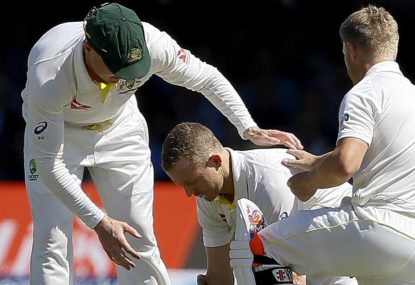Chris Rogers’ Test career may have come to a premature end.
The pugnacious left-hander announced ahead of this Ashes series that it would be his last beneath the baggy green.
However, a dizzy spell that took effect in the middle of Lord’s some two days after he was struck in the helmet by James Anderson may see the curtain drawn early.
For Rogers it was a case of déjà vu, and a very recent one to boot.
Two days out from the first Test in the Caribbean in early June he was struck on the helmet by a local net bowler.
The effects of that blow ruled him out of the entire two-Test series.
In cricket terms that was a long break from action as a result of a hit to the helmet.
But that blow was by no means the first in Rogers 16-year, 294-match first-class career.
In the aftermath of the blow in he suffered at Rousseau, Rogers reflected on the number of times he had been struck in the head while batting.
“To be honest, I didn’t think much of the hit on the head. I’ve been hit on the head quite a few times. I thought it was just another one. But then I just didn’t start to feel great. I spoke to the doc and didn’t expect him to rule me out of the Test, but he did,” Rogers said.
“I was a little bit surprised at the time but since then I still haven’t quite recovered. I’ve had some pretty bad days so I think the doc was right. He made the right call.
“I’ve never really had symptoms like this, I must admit. Even just running and taking a few catches and then feeling terrible for the rest of the day. It’s been a bit of a wake-up call.”
The first ball of day two of the Lord’s Test provided another wake-up call, when on 158, he misjudged a short delivery from Anderson and was struck on the helmet behind the right ear.
There was a short delay as Rogers was attended to by team doctor Peter Brukner who stemmed some light bleeding behind his ear.
When Rogers resumed there appeared to be no ill effects in the lead-in to him being dismissed for a career-best 173.
In was during the opening session of the fourth day that the aftermath was first experienced.
Clearly dizzy and dazed – with 49 alongside his name on the scoreboard – he walked across the pitch and went down on one knee as opening partner David Warner signalled for assistance from the rooms.
This time there was no continuing with Dr Brukner leading Rogers back to the pavilion.
Interestingly, Rogers is one of the few Australian batsmen who have adopted the modified helmet that was hastily manufactured following the tragic death of Phillip Hughes in November.
The area he was hit was eerily close to where Hughes was struck his fatal blow.
Given Rogers has declared that he only has three further Tests ahead of his retirement it brings into question whether or not he should depart the scene earlier.
Concussion as a result of numerous blows to the head has been something that many sporting codes in Australia have been wrestling with of late.
The standing down of Rogers in the Caribbean was part of a newly adopted policy by Cricket Australia of dealing with players who have suffered a concussion.
A landmark ruling from a US Court in April approved a plan whereby former-NFL players would be entitled to a slice of US$1bn over the next 65 years as a result of on-field concussions.
It is estimated that as many as 6000 of the nearly 20,000 retired players will suffer from Alzheimer’s disease or moderate dementia in the future after years of having received blows to the head.
The ruling sent shivers through the boardrooms of sports like Australian football and the rugby codes in this country.
Rogers is a thoughtful man.
He is often portrayed by his teammates as being the one who is either on his Kindle reading or doing crosswords to help kill time while on tour.
He will now, along with medical staff, have to decide whether he gives himself more time for those pursuits at the expense of extending his career.
He has been Australia’s most consistent batsman through the first two Tests with scores of 95, 10, 173 and 49 not out.
After 22 Tests, and with five centuries to his name, he has taken his career average to a credible 44.3.
Having been recalled to the side after a solitary Test seven years ago he has proven himself to be a highly capable Test opener.
While he will be torn to play the last three Tests of the current series, he may well be advised to call it a day with his long-term health a far more important consideration.
Should he either be ruled out or chooses to step down of his own volition, it will be a body blow to the aspirations of Michael Clarke’s team.
Rogers has scored four of his five tons against the old enemy and in 12 matches, both home-and-away, he has scored 1157 runs at 52.6.
As was the case in the Caribbean when Rogers was sidelined, it will be Shaun Marsh who will be thrown to the top of the order.
He fared reasonably against West Indies with a four innings aggregate of 112 at 37.3, however opening in Tests in England is a whole different ballgame.
But in truth, when it comes to the long-term wellbeing and health of a sportsman, the decision to err on the side of caution is the best option.
And with Chris Rogers, that may well be the course of action that is required for the risk of another blow maybe more than his body can properly absorb.





























































































